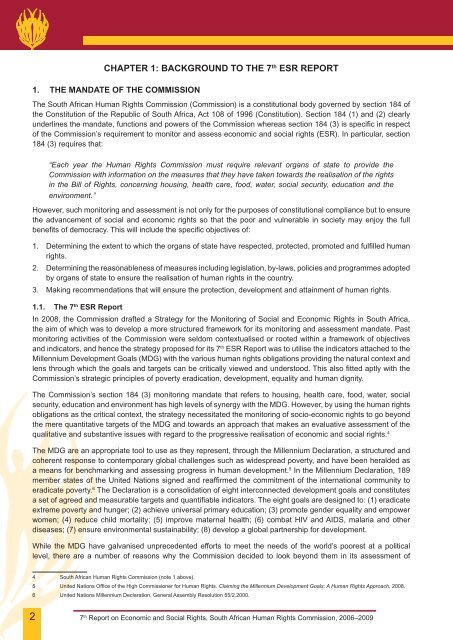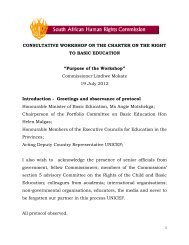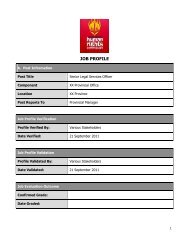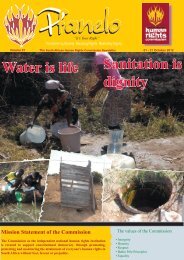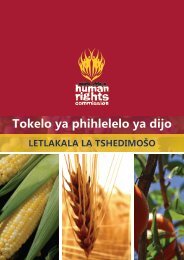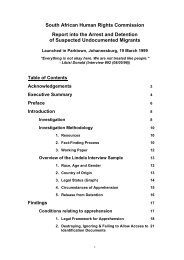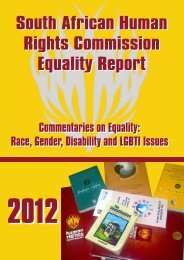Chapter 1 - South African Human Rights Commission
Chapter 1 - South African Human Rights Commission
Chapter 1 - South African Human Rights Commission
- No tags were found...
You also want an ePaper? Increase the reach of your titles
YUMPU automatically turns print PDFs into web optimized ePapers that Google loves.
CHAPTER 1: BACKGROUND TO THE 7 th ESR REPORT<br />
1. THE MANDATE OF THE COMMISSION<br />
The <strong>South</strong> <strong>African</strong> <strong>Human</strong> <strong>Rights</strong> <strong>Commission</strong> (<strong>Commission</strong>) is a constitutional body governed by section 184 of<br />
the Constitution of the Republic of <strong>South</strong> Africa, Act 108 of 1996 (Constitution). Section 184 (1) and (2) clearly<br />
underlines the mandate, functions and powers of the <strong>Commission</strong> whereas section 184 (3) is speci c in respect<br />
of the <strong>Commission</strong>’s requirement to monitor and assess economic and social rights (ESR). In particular, section<br />
184 (3) requires that:<br />
“Each year the <strong>Human</strong> <strong>Rights</strong> <strong>Commission</strong> must require relevant organs of state to provide the<br />
<strong>Commission</strong> with information on the measures that they have taken towards the realisation of the rights<br />
in the Bill of <strong>Rights</strong>, concerning housing, health care, food, water, social security, education and the<br />
environment.”<br />
However, such monitoring and assessment is not only for the purposes of constitutional compliance but to ensure<br />
the advancement of social and economic rights so that the poor and vulnerable in society may enjoy the full<br />
bene ts of democracy. This will include the speci c objectives of:<br />
1. Determining the extent to which the organs of state have respected, protected, promoted and ful lled human<br />
rights.<br />
2. Determining the reasonableness of measures including legislation, by-laws, policies and programmes adopted<br />
by organs of state to ensure the realisation of human rights in the country.<br />
3. Making recommendations that will ensure the protection, development and attainment of human rights.<br />
1.1. The 7 th ESR Report<br />
In 2008, the <strong>Commission</strong> drafted a Strategy for the Monitoring of Social and Economic <strong>Rights</strong> in <strong>South</strong> Africa,<br />
the aim of which was to develop a more structured framework for its monitoring and assessment mandate. Past<br />
monitoring activities of the <strong>Commission</strong> were seldom contextualised or rooted within a framework of objectives<br />
and indicators, and hence the strategy proposed for its 7 th ESR Report was to utilise the indicators attached to the<br />
Millennium Development Goals (MDG) with the various human rights obligations providing the natural context and<br />
lens through which the goals and targets can be critically viewed and understood. This also tted aptly with the<br />
<strong>Commission</strong>’s strategic principles of poverty eradication, development, equality and human dignity.<br />
The <strong>Commission</strong>’s section 184 (3) monitoring mandate that refers to housing, health care, food, water, social<br />
security, education and environment has high levels of synergy with the MDG. However, by using the human rights<br />
obligations as the critical context, the strategy necessitated the monitoring of socio-economic rights to go beyond<br />
the mere quantitative targets of the MDG and towards an approach that makes an evaluative assessment of the<br />
qualitative and substantive issues with regard to the progressive realisation of economic and social rights. 4<br />
The MDG are an appropriate tool to use as they represent, through the Millennium Declaration, a structured and<br />
coherent response to contemporary global challenges such as widespread poverty, and have been heralded as<br />
a means for benchmarking and assessing progress in human development. 5 In the Millennium Declaration, 189<br />
member states of the United Nations signed and reaf rmed the commitment of the international community to<br />
eradicate poverty. 6 The Declaration is a consolidation of eight interconnected development goals and constitutes<br />
a set of agreed and measurable targets and quanti able indicators. The eight goals are designed to: (1) eradicate<br />
extreme poverty and hunger; (2) achieve universal primary education; (3) promote gender equality and empower<br />
women; (4) reduce child mortality; (5) improve maternal health; (6) combat HIV and AIDS, malaria and other<br />
diseases; (7) ensure environmental sustainability; (8) develop a global partnership for development.<br />
While the MDG have galvanised unprecedented efforts to meet the needs of the world’s poorest at a political<br />
level, there are a number of reasons why the <strong>Commission</strong> decided to look beyond them in its assessment of<br />
4 <strong>South</strong> <strong>African</strong> <strong>Human</strong> <strong>Rights</strong> <strong>Commission</strong> (note 1 above).<br />
5 United Nations Of ce of the High <strong>Commission</strong>er for <strong>Human</strong> <strong>Rights</strong>. Claiming the Millennium Development Goals: A <strong>Human</strong> <strong>Rights</strong> Approach, 2008.<br />
6 United Nations Millennium Declaration. General Assembly Resolution 55/2.2000.<br />
2<br />
7 th Report on Economic and Social <strong>Rights</strong>, <strong>South</strong> <strong>African</strong> <strong>Human</strong> <strong>Rights</strong> <strong>Commission</strong>, 2006–2009


